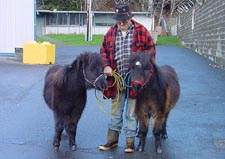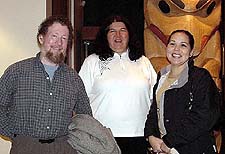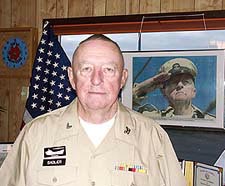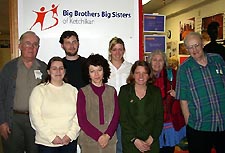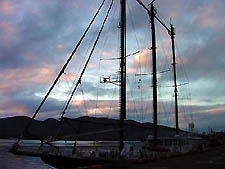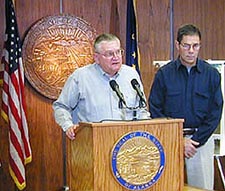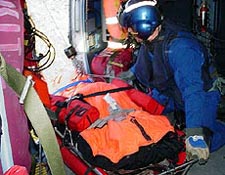November 2002
Search-----Read Comments ----Sitnews:
News & Photos Archives
E-mail
Your News Releases & Photos
Fax News Releases: 907-225-8590
Today's Top News:
Alaska & Ketchikan Sources
Profile
America - Mark Twain
 Listen
To This Story In RealAudio - Saturday, November 30th. One
of America's most enduring writers and humorists was born on
this day in 1835, in the little town of Florida, Missouri. His
name was Samuel Clemens, but he was much better known as Mark
Twain. Much of his fame stemmed from two novels about boyhood
on the Mississippi River - Tom Sawyer and Huckleberry Finn, which
have depicted life and youthful adventure to generations of young
people throughout the world. When Twain wrote about Tom and Huck
around 1880, the United States had a population of some 50-million
and Missouri less than 2-million. Today, the U.S. is home to
more than 281-million people and Missouri has a population approaching
6-million. (Source
US Census Bureau) Listen
To This Story In RealAudio - Saturday, November 30th. One
of America's most enduring writers and humorists was born on
this day in 1835, in the little town of Florida, Missouri. His
name was Samuel Clemens, but he was much better known as Mark
Twain. Much of his fame stemmed from two novels about boyhood
on the Mississippi River - Tom Sawyer and Huckleberry Finn, which
have depicted life and youthful adventure to generations of young
people throughout the world. When Twain wrote about Tom and Huck
around 1880, the United States had a population of some 50-million
and Missouri less than 2-million. Today, the U.S. is home to
more than 281-million people and Missouri has a population approaching
6-million. (Source
US Census Bureau)
 Ketchikan:
Mile
15 To Settlers Cove Under Construction - The construction on the 3.2 miles of
North Tongass Highway between the end of the pavement at Mile
Post 15 and Settler's Cove began approximately a week ago.... Ketchikan:
Mile
15 To Settlers Cove Under Construction - The construction on the 3.2 miles of
North Tongass Highway between the end of the pavement at Mile
Post 15 and Settler's Cove began approximately a week ago....
Friday - November 29, 2002
- 6:55 pm
Ketchikan: Sunrise photograph by Christopher Wilhelm...
Friday
- November 29, 2002 - 12:15 am
Alaska: Information Technology Plan Maps Future For State -- Plan Addresses
Use of Technology in State Government...
Friday
- November 29, 2002 - 11:00 am
Alaska: State Streamlines Coastal Permit Process -- Improved Coordination
Benefits Industry, Coastal Communities, Citizens...
Friday
- November 29, 2002 - 11:00 am
Profile
America - First
Auto Race
 Listen
To This Story In RealAudio - Friday, November 29th. Newspapers
on this day in 1895 were full of news about the nation's first
automobile race - held the day before, among vehicles which still
looked like buggies. Just before 9 a.m., six of what were then
called "motocycles," left Chicago's Jackson Park for
a 54-mile run to Evanston, Illinois, and back through the snow.
Number 5, driven by inventor Frank Duryea, won the race in just
over 10 hours, at an average speed of about 7.5 miles an hour.
Just as with horse racing, competition helped to refine automobiles.
By 1911, the first Indianapolis 500 was held, leading to such
developments as the rear view mirror. Today across the country,
about 13-million people a year attend a motor racing event. (Source US Census Bureau) Listen
To This Story In RealAudio - Friday, November 29th. Newspapers
on this day in 1895 were full of news about the nation's first
automobile race - held the day before, among vehicles which still
looked like buggies. Just before 9 a.m., six of what were then
called "motocycles," left Chicago's Jackson Park for
a 54-mile run to Evanston, Illinois, and back through the snow.
Number 5, driven by inventor Frank Duryea, won the race in just
over 10 hours, at an average speed of about 7.5 miles an hour.
Just as with horse racing, competition helped to refine automobiles.
By 1911, the first Indianapolis 500 was held, leading to such
developments as the rear view mirror. Today across the country,
about 13-million people a year attend a motor racing event. (Source US Census Bureau)
 |
 Ketchikan:
"Red Skies" Photo Gallery... Ketchikan:
"Red Skies" Photo Gallery...
Wednesday - November 27, 2002 - 7:00 pm
Photos by Melody McAllister
Front Page Photo Wednesday
- November 27, 2002
|
"Home Is Where
The Heart Is"
Photo by Gigi Pilcher
Front Page Photo Wednesday,
November 27, 2002
Click on photo to
view a larger photo...
|

|
Alaska: State Signs Trans Alaska Pipeline Renewal
-- Extends TAPS Right-of-Way Lease for 30 More Years...
Wednesday
- November 27, 2002 - 12:40 am
Alaska: Revenue Forecast Predicts Higher Long-Term Oil
Prices -- Even at higher prices, Budget Reserve Fund could
run out June 2005...
Wednesday
- November 27, 2002 - 12:40 am
Alaska: Knowles Honors Workstar Award Winners --
Businesses, Workers Make Welfare Reform a Success...
Wednesday
- November 27, 2002 - 12:40 am
Alaska: Flags Lowered For James Hesterberg -- Corrections
Officer, 4 Prisoners Killed in Seward Accident...
Wednesday
- November 27, 2002 - 12:40 am
Ketchikan: EPA,
Trident Seafoods Agree on Remedy for Fish Waste Problems - Company
to pay $96K for illegal 'eruptions' of putrid waste that fouled
water and angered residents...
Tuesday - November 26,
2002 - 12:30 am
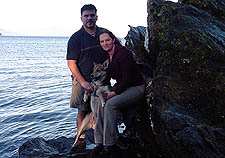 |
Sunny
Sunday Fun
Photo
by Gigi Pilcher
 Photo Gallery: Ketchikan residents
David & Danita Scott & Aggro enjoy the sun on Sunday
at Settlers Cove. Click on photo or link to view more photos... Photo Gallery: Ketchikan residents
David & Danita Scott & Aggro enjoy the sun on Sunday
at Settlers Cove. Click on photo or link to view more photos...
Tuesday
- November 26, 2002 - 12:30 am
|
Profile America
- Peanut Butter
 Listen
To This Story In RealAudio - Tuesday,
November 26th. One of life's simple pleasures is being celebrated
- it's Peanut Butter Lovers Month. Proclaimed as one of America's
favorite foods - and certainly its most popular sandwich - peanut
butter was first offered to the public at the St. Louis Exposition
of 1904. But peanut butter as we know it - with the peanuts roasted
and the product churned like butter to be smooth and not have
the oil separate - didn't appear on grocery store shelves until
1922. Our love of peanut butter, whether smooth or chunky, accounts
for a large part of the nearly 6.2 pounds of shelled peanuts
each of us consumes in a year - which brings in just under a
billion dollars to the farmers who grow them. (Source US Census Bureau) Listen
To This Story In RealAudio - Tuesday,
November 26th. One of life's simple pleasures is being celebrated
- it's Peanut Butter Lovers Month. Proclaimed as one of America's
favorite foods - and certainly its most popular sandwich - peanut
butter was first offered to the public at the St. Louis Exposition
of 1904. But peanut butter as we know it - with the peanuts roasted
and the product churned like butter to be smooth and not have
the oil separate - didn't appear on grocery store shelves until
1922. Our love of peanut butter, whether smooth or chunky, accounts
for a large part of the nearly 6.2 pounds of shelled peanuts
each of us consumes in a year - which brings in just under a
billion dollars to the farmers who grow them. (Source US Census Bureau)
Alaska: Transportation, Fish and Game Ink Pact to Allow
Access to Habitat -- Agreement To Ensure Safe Fish Passage...
Monday - November 25, 2002
- 6:45 pm
Alaska: Flags Lowered Tuesday For Edward Naughton
-- Represented Kodiak in Alaska Legislature
Monday - November 25, 2002
- 6:45 pm
Profile
America - China
Clipper
 Listen
To This Story In RealAudio - Monday, November 25th. Headlines around the
world on this day in 1935 noted an aviation milestone - the arrival
of a Pan American Martin 130 flying boat in Manila - opening
airmail service across the Pacific. The historic importance of
the event was underlined by a crowd of some 20-thousand people
who gathered to watch the China Clipper take off from San Francisco
for its transoceanic trip of almost 60 hours. Commercial passenger
service on the route started the next year. In 1935, there were
just over 450 commercial airliners, and they carried about 680-thousand
passengers. Today, U.S. airlines operate some 7,600 aircraft
and carry over 635-million people each year (Source US Census Bureau) Listen
To This Story In RealAudio - Monday, November 25th. Headlines around the
world on this day in 1935 noted an aviation milestone - the arrival
of a Pan American Martin 130 flying boat in Manila - opening
airmail service across the Pacific. The historic importance of
the event was underlined by a crowd of some 20-thousand people
who gathered to watch the China Clipper take off from San Francisco
for its transoceanic trip of almost 60 hours. Commercial passenger
service on the route started the next year. In 1935, there were
just over 450 commercial airliners, and they carried about 680-thousand
passengers. Today, U.S. airlines operate some 7,600 aircraft
and carry over 635-million people each year (Source US Census Bureau)
Profile America -Diabetes Month
 Listen
To This Story In RealAudio - Sunday,
November 24th. Each year, November is National Diabetes Month
- with the goal of making more people aware of the serious nature
of the disease - and how to detect and control it. Diabetes can
cause many complications including kidney failure; loss of feeling
in the toes and feet; and it's the leading cause of new cases
of blindness. The disease is on the rise in the U.S. - and some
experts even refer to the recent increases as an epidemic
fueled by our lifestyle which leads to being inactive and overweight.
Across the country, just over 11-million people are known to
have diabetes, and it's estimated that another 6-million are
undiagnosed. About 65-thousand deaths a year are attributed to
diabetes - up from 48-thousand a decade ago. (Source US Census Bureau) Listen
To This Story In RealAudio - Sunday,
November 24th. Each year, November is National Diabetes Month
- with the goal of making more people aware of the serious nature
of the disease - and how to detect and control it. Diabetes can
cause many complications including kidney failure; loss of feeling
in the toes and feet; and it's the leading cause of new cases
of blindness. The disease is on the rise in the U.S. - and some
experts even refer to the recent increases as an epidemic
fueled by our lifestyle which leads to being inactive and overweight.
Across the country, just over 11-million people are known to
have diabetes, and it's estimated that another 6-million are
undiagnosed. About 65-thousand deaths a year are attributed to
diabetes - up from 48-thousand a decade ago. (Source US Census Bureau)
Ketchikan,
Craig, Metlakatla:
Governor-elect Murkowski is looking for input
from Alaskans across the state -- Public Meetings Scheduled
In Ketchikan Nov. 25th & 26th
Saturday
- November 23, 2002 - 6:00 pm
Profile America - Life Magazine
 Listen
To This Story In RealAudio - Saturday, November 23rd. One of the nation's
most influential and popular magazines published its first issue
on this day in 1936. At the time, Life Magazine was a startling
innovation. Taking advantage of the recently developed small
35-millimeter camera which could take pictures anywhere, Life
established the art of photo journalism. For 36 years, millions
of American homes eagerly awaited their weekly issues, which
chronicled American society and culture in pictures that were
a personal experience for readers. Life Magazine continues publishing
as a monthly. Now, no single magazine has the market share that
Life enjoyed in the 1930s and '40s. The average American today
spends about 51-dollars on magazines and 77 hours reading them.
(Source
US Census Bureau) Listen
To This Story In RealAudio - Saturday, November 23rd. One of the nation's
most influential and popular magazines published its first issue
on this day in 1936. At the time, Life Magazine was a startling
innovation. Taking advantage of the recently developed small
35-millimeter camera which could take pictures anywhere, Life
established the art of photo journalism. For 36 years, millions
of American homes eagerly awaited their weekly issues, which
chronicled American society and culture in pictures that were
a personal experience for readers. Life Magazine continues publishing
as a monthly. Now, no single magazine has the market share that
Life enjoyed in the 1930s and '40s. The average American today
spends about 51-dollars on magazines and 77 hours reading them.
(Source
US Census Bureau)
 Petersburg,
AK - Kake Youth Wins National Fishing Derby... Petersburg,
AK - Kake Youth Wins National Fishing Derby...
Friday
- November 22, 2002 - 12:30 am
Alaska:
Gasoline Price Investigation Closed -- Three-Year
Probe Finds No Evidence of Price Fixing at the Pumps...
Friday
- November 22, 2002 - 12:30 am
Alaska: Flags Lowered Friday For Leo Rhode - - Represented
Homer in Alaska Legislature...
Friday
- November 22, 2002 - 12:30 am
Alaska:
Stevens Invites Alaskans To Participate In The
Veterans History Project -- The
Library of Congress is Asking All Americans to Share Their Memories
of Veterans During This Holiday Season...
Friday
- November 22, 2002 - 12:30 am
Ketchikan & North Pole:
Two Alaska Fire Departments to Receive Assistance
From Firefighters Grant Program...
Friday
- November 22, 2002 - 12:30 am
Profile
America - NHL Founded
 Listen
To This Story In RealAudio - Friday, November 22nd. One of the fastest
moving professional sports was founded on this day in 1917, at
a meeting in Montreal. At the time, the National Hockey League
was made up of two teams from Montreal, one from Ottawa and one
from Quebec. There were many changes in the early years, and
at one point, the NHL was down to only three teams. The first
American team admitted to the league was Boston in 1924. Two
years later, the Stanley Cup came under control of the NHL -
the oldest trophy in North America for professional athletic
competition. Today, artificial ice and television have turned
what was a winter sport into a truly international success. In
the U.S., some 18-million fans a year attend NHL games. (Source US Census Bureau) Listen
To This Story In RealAudio - Friday, November 22nd. One of the fastest
moving professional sports was founded on this day in 1917, at
a meeting in Montreal. At the time, the National Hockey League
was made up of two teams from Montreal, one from Ottawa and one
from Quebec. There were many changes in the early years, and
at one point, the NHL was down to only three teams. The first
American team admitted to the league was Boston in 1924. Two
years later, the Stanley Cup came under control of the NHL -
the oldest trophy in North America for professional athletic
competition. Today, artificial ice and television have turned
what was a winter sport into a truly international success. In
the U.S., some 18-million fans a year attend NHL games. (Source US Census Bureau)
|
Weather For The
Webbed Footed
Ketchikan: Wednesday was certainly a day for
the webbed footed. As of midnight Wednesday, the Federal Aviation
Administration's Flight Service Station located at the Ketchikan
International Airport reported a total of 4.21 inches of rain
over a period of 24 hours. Click
on this link or the photo to read more...
Pissarro A Ketchikan
Swan Goose
photo by MC Kauffman
|

|
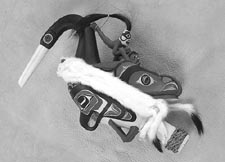 |
Ketchikan: The City of Ketchikan Museum Department
unveils the 2002 Totem Heritage Center Student and Instructor
Art Show on November 22, 2002, which will be on display at the
Totem Heritage Center until December 21. Click on the links or photo to read more....
Thursday - November 21,
2002 - 12:15 am |
Alaska: State
Offers Spill Cleanup Assistance To Spain -- Tanker "Prestige"
Sinks with 20.5 Million Gallons of Heavy Crude...
Thursday - November 21,
2002 - 12:15 am
Ketchikan:
Alaska
Discovery Center Announces Shotridge To Work In Ketchikan...
Thursday - November 21,
2002 - 12:15 am
Alaska:
Telecommunications
Study Released -- Examines Industry and Regulations in Alaska...
Thursday - November 21,
2002 - 12:15 am
Ketchikan: Annual
Winter Art Faire To Be Held Nov. 29th-30th...
Thursday - November 21,
2002 - 12:15 am
Profile
America - Congress
 Listen
To This Story In RealAudio - Thursday,
November 21st. The United States Congress met for the first time
in the District of Columbia on this day in 1800. Until then,
it had met in Philadelphia. Ever since President George Washington
laid the cornerstone for the Capitol in 1793, the District had
been planned as the permanent home for the U.S. government. By
1800, enough of the Capitol had been completed for the members
of the 6th Congress to move in - consisting of 83 Federalists
and 55 Democrat-Republicans. One senator found D.C. to be "lacking
in houses, cellars, kitchens, well-informed men and amiable women."
Only the villages of Georgetown and Alexandria offered any amenities.
In 1800, the population of the District was 8-thousand. Today,
it is 572-thousand. Listen
To This Story In RealAudio - Thursday,
November 21st. The United States Congress met for the first time
in the District of Columbia on this day in 1800. Until then,
it had met in Philadelphia. Ever since President George Washington
laid the cornerstone for the Capitol in 1793, the District had
been planned as the permanent home for the U.S. government. By
1800, enough of the Capitol had been completed for the members
of the 6th Congress to move in - consisting of 83 Federalists
and 55 Democrat-Republicans. One senator found D.C. to be "lacking
in houses, cellars, kitchens, well-informed men and amiable women."
Only the villages of Georgetown and Alexandria offered any amenities.
In 1800, the population of the District was 8-thousand. Today,
it is 572-thousand.
Evening
Lights of Ketchikan
Front
page photo Wednesday,
November 20, 2002
photo by Gigi Pilcher
Click
on the photo to
view a larger photo...
|

|
 Ketchikan: School Board Seats Harpold... Ketchikan: School Board Seats Harpold...
Wednesday
- November 20, 2002 - 12:05 am
Ketchikan
& Statewide:
 Alaska's Unemployment Holds Steady - Ketchikan's
Unemployment 7.5% Up From September's 7.2%... Alaska's Unemployment Holds Steady - Ketchikan's
Unemployment 7.5% Up From September's 7.2%...
Wednesday
- November 20, 2002 - 12:05 am
Alaska: Knowles Names State Trade Representative For
China - Position Underscores Growing Importance of Asian Trade
Partner...
Wednesday
- November 20, 2002 - 12:05 am
Alaska: Homeland Security Bill Passes U.S. Senate - Stevens
worked to preserve Coast Guard's vital role in Alaska...
Wednesday
- November 20, 2002 - 12:05 am

Alaska: Shaking it Up in Alaska: ShakeMap Released for
7.9 Earthquake...
Wednesday
- November 20, 2002 - 12:05 am
Alaska: Four Companies Fined $5 Million for Pacific Ocean
Oil Dumping Conspiracy...
Wednesday
- November 20, 2002 - 12:05 am
Alaska
& Nationwide:
Searching for 'Ms. America': Best and Worst States
for Women -- Alaska ranked 6th as one of the best states......
Wednesday
- November 20, 2002 - 12:05 am
Profile
America - Dick Tracy
 Listen
To This Story In RealAudio - Wednesday,
November 20th. Today is the anniversary of the birth of Chester
Gould - the man who thought up the two-way wrist radio and the
square-jawed, comic-strip detective who wore it - Dick Tracy.
Outfitted in a fedora hat and rain coat, Dick Tracy matched wits
with an assortment of bad guys who were drawn exactly as they
were named - the Mole, Pruneface and Flat Top, among others.
The strip premiered in 1931 in the Detroit Daily Mirror
and was soon syndicated in nearly a thousand newspapers worldwide.
At the time, there were just under 2-thousand daily newspapers
in the U.S. Chester Gould died in 1985, but Dick Tracy is still
proving that crime does not pay in a modern day version of the
comic strip, appearing in many of the nation's 15-hundred dailies. Listen
To This Story In RealAudio - Wednesday,
November 20th. Today is the anniversary of the birth of Chester
Gould - the man who thought up the two-way wrist radio and the
square-jawed, comic-strip detective who wore it - Dick Tracy.
Outfitted in a fedora hat and rain coat, Dick Tracy matched wits
with an assortment of bad guys who were drawn exactly as they
were named - the Mole, Pruneface and Flat Top, among others.
The strip premiered in 1931 in the Detroit Daily Mirror
and was soon syndicated in nearly a thousand newspapers worldwide.
At the time, there were just under 2-thousand daily newspapers
in the U.S. Chester Gould died in 1985, but Dick Tracy is still
proving that crime does not pay in a modern day version of the
comic strip, appearing in many of the nation's 15-hundred dailies.
Profile
America - Automated Toll Booths
 Listen
To This Story Listen
To This Story
In RealAudio
- Tuesday, November 19th. A device many people resent - but which
saves a lot of time - first went into service on this day in
1954, when the first automatic toll collection machine appeared
in the U.S. It was at the Union Toll Plaza on New Jersey's Garden
State Parkway. Motorists dropped a quarter into a wire mesh hopper,
and a green light told them to go ahead. The idea soon caught
on at toll roads around the country, reducing the number of booth
attendants and speeding cars on their way. There are just under
4-million miles of highways in the U.S. While it might seem like
more, there are just 48-hundred miles of toll roads, bridges
and tunnels.(Source
U.S. Census Bureau)
Profile America - Time Zones
 Listen
To This Story In RealAudio - Sunday, November 17th. One of the things we
take for granted is the organization of time across the country.
But as the frontier closed and America truly became a nation
from coast to coast, travel schedules were chaotic. This week
in 1883, a Connecticut school teacher named Charles Dowd proposed
the idea of dividing the nation into time zones to standardize
railroad timetables. A year later, an international conference
applied the same concept to the entire world. In the U.S., time
zones were not made law until 1918. Keeping time is not only
important - it's also a fashion statement. In the U.S., making
watches and clocks is a 921-million dollar a year business, creating
jobs for more than 63-hundred people.(Source U.S. Census Bureau) Listen
To This Story In RealAudio - Sunday, November 17th. One of the things we
take for granted is the organization of time across the country.
But as the frontier closed and America truly became a nation
from coast to coast, travel schedules were chaotic. This week
in 1883, a Connecticut school teacher named Charles Dowd proposed
the idea of dividing the nation into time zones to standardize
railroad timetables. A year later, an international conference
applied the same concept to the entire world. In the U.S., time
zones were not made law until 1918. Keeping time is not only
important - it's also a fashion statement. In the U.S., making
watches and clocks is a 921-million dollar a year business, creating
jobs for more than 63-hundred people.(Source U.S. Census Bureau)
 Ketchikan: Ketchikan Youth Court Holds Graduation - New
members sworn in... Ketchikan: Ketchikan Youth Court Holds Graduation - New
members sworn in...
Saturday
- November 16, 2002 - 12:20 am
 Ketchikan: Big Brothers Big Sisters News - First Big Brother
matches announced for Ketchikan... Ketchikan: Big Brothers Big Sisters News - First Big Brother
matches announced for Ketchikan...
Saturday
- November 16, 2002 - 12:20 am
Profile
America - Longhorn
Rodeo
 Listen
To This Story In RealAudio - Saturday, November 16th. Horses and bulls,
cowboys, clowns and an excited crowd. It's the rodeo. And in
Nashville, Tennessee, today not just any rodeo - but the Longhorn
Championship finals. All year long, more than 12-hundred riders
compete in qualifying rounds for an invitation to the three-day
finals. Now, 72 of the best are competing in six different events
for trophy belt buckles, saddles and even a new pickup truck.
The events include bareback and saddle bronc riding, steer wrestling,
calf roping - and the most dangerous and popular of the events
- bull riding. Across the U.S., there are some 700 rodeos held
each year. They draw an audience of nearly 6-million fans, cheering
on about 11-thousand professional riders.(Source U.S. Census Bureau) Listen
To This Story In RealAudio - Saturday, November 16th. Horses and bulls,
cowboys, clowns and an excited crowd. It's the rodeo. And in
Nashville, Tennessee, today not just any rodeo - but the Longhorn
Championship finals. All year long, more than 12-hundred riders
compete in qualifying rounds for an invitation to the three-day
finals. Now, 72 of the best are competing in six different events
for trophy belt buckles, saddles and even a new pickup truck.
The events include bareback and saddle bronc riding, steer wrestling,
calf roping - and the most dangerous and popular of the events
- bull riding. Across the U.S., there are some 700 rodeos held
each year. They draw an audience of nearly 6-million fans, cheering
on about 11-thousand professional riders.(Source U.S. Census Bureau)
Alaska: Knowles Appoints Two To Anchorage Superior Court - John Suddock, Philip Volland
Ascend to Judgeships...
Friday - November 15, 2002 - 3:45 pm
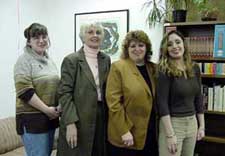
Left to right: ORCA Parenting
Assistant Amy Schmitt, ORCA Parenting Program Director Dixie
Duehn, Ketchikan Resource Center Coordinator Cynthia Monrean,
and Ketchikan Resource Center Receptionist Jessica Stone...
|
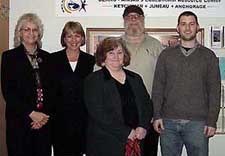
Left to right: Nancy Duhaime,
SERRC Program Coordinator; JoAnn Henderson, Executive Director
of SERRC; Ketchikan Adult Education Center staff Bonnie Bonne',
Mike Doyle (behind Bonnie) and Dan Hill, VISTA...
|
Ketchikan: Two Ketchikan programs, the Ketchikan
Adult Education Center and the Ketchikan Resource Center, held
open houses Thursday to welcome the public to their new locations
and provide information about their services. Read more...
Friday - November 15, 2002
- 12:45 am |
Profile America
- First Hearing Aid
 Listen
To This Story In RealAudio - Friday, November 15th. There was good news
for the hard of hearing on this day in 1901 - as Miller Reese
Hutchinson, of New York, patented the first portable electric
hearing aid. Called the "acousticon," the device was
a smaller version of previous tabletop units. While portable,
it still had three components and used batteries that only lasted
for a few hours. Before these electrical devices, people held
a hearing trumpet up to their ear and pointed it at the person
speaking, or simply cupped a hand behind their ear. Now, tiny
digital hearing aids that users can program for maximum effect
help millions to hear normal conversation. In the U.S., there
are nearly 8-million adults who have difficulty hearing, and
832-thousand who cannot hear at all.(Source U.S. Census Bureau) Listen
To This Story In RealAudio - Friday, November 15th. There was good news
for the hard of hearing on this day in 1901 - as Miller Reese
Hutchinson, of New York, patented the first portable electric
hearing aid. Called the "acousticon," the device was
a smaller version of previous tabletop units. While portable,
it still had three components and used batteries that only lasted
for a few hours. Before these electrical devices, people held
a hearing trumpet up to their ear and pointed it at the person
speaking, or simply cupped a hand behind their ear. Now, tiny
digital hearing aids that users can program for maximum effect
help millions to hear normal conversation. In the U.S., there
are nearly 8-million adults who have difficulty hearing, and
832-thousand who cannot hear at all.(Source U.S. Census Bureau)
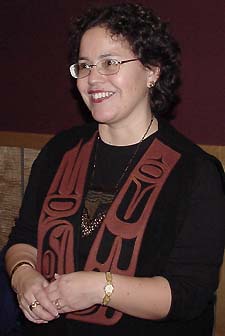 Dr. Delores (Dolly)
Garza
Dr. Delores (Dolly)
Garza
photo by Gigi Pilcher
|
Garza Presents Subsistence
Gathering Program
National American Indian
Heritage Month Celebrated With Special Programs
Ketchikan: In celebration of National American
Indian Heritage Month the Southeast Alaska Discovery Center presented
a special program on subsistence gathering on Tuesday evening,
November 12th, at the Discovery Center.
Ketchikan residents, young
and old alike, were treated to a very informative program as
well as culinary delights by Dr. Delores (Dolly) Garza, a Professor
of the University of Alaska Marine Advisory Program.
 Gayle Nixon of the Southeast Alaska
Discovery Center introduced Professor Garza, and the Professor
addressed the crowd in her maternal language of Haida and followed
Native tradition by giving homage to her house and clan. Gayle Nixon of the Southeast Alaska
Discovery Center introduced Professor Garza, and the Professor
addressed the crowd in her maternal language of Haida and followed
Native tradition by giving homage to her house and clan.
Read more - view the photo gallery....
Thursday - November 14,
2002 -12:45 am
|
Profile America - Dow Jones Index
 Listen
To This Story In RealAudio - Thursday, November 14th. The ups and downs
of the New York Stock Market have been in the news a lot this
year. The surges and drops have overshadowed the fact that in
the long run, the market has made remarkable advances. It was
on this day 30 years ago that the Dow Jones Index first topped
the 1-thousand mark. Developed by Charles Henry Dow in 1889,
the index tracks broad patterns in the U.S. economy. In 1972,
the index was made up largely of stocks in the manufacturing
sector. Today, its components mirror the change to a more diverse
economy. As more Americans buy stocks, the market has become
more active. In 1980, 45-million shares were traded on an average
day. Now, that figure is over 1-billion shares. (Source U.S. Census
Bureau) Listen
To This Story In RealAudio - Thursday, November 14th. The ups and downs
of the New York Stock Market have been in the news a lot this
year. The surges and drops have overshadowed the fact that in
the long run, the market has made remarkable advances. It was
on this day 30 years ago that the Dow Jones Index first topped
the 1-thousand mark. Developed by Charles Henry Dow in 1889,
the index tracks broad patterns in the U.S. economy. In 1972,
the index was made up largely of stocks in the manufacturing
sector. Today, its components mirror the change to a more diverse
economy. As more Americans buy stocks, the market has become
more active. In 1980, 45-million shares were traded on an average
day. Now, that figure is over 1-billion shares. (Source U.S. Census
Bureau)
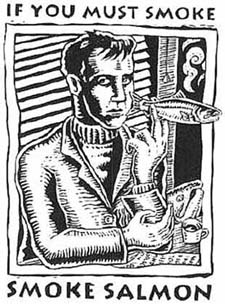
Graphic by Ray Troll |
The Great American
Smokeout
Ketchikan: Imagine a day when millions of people
put their cigarettes out - many for the very last time. On Saturday,
November 16th, Ketchikan smokers will be encouraged to quit smoking
for a day or longer by joining in the Great American Smokeout.
Alaskans for Drug Free Youth (ADFY) will hold a typically "Ketchikan"
event entitled "If you must smoke, smoke salmon."
Ray Troll, Ketchikan artist, allowed ADFY to use his
drawing of the same title for the event's logo. On
that day, from 1 pm to 4 pm, the public is invited to gather
at the Holy Name Catholic Church Gym for free barbecue and smoked
salmon, a salmon recipe contest, games and family activities,
prizes, presentations on smoking and secondhand smoke, raffle
drawings and Ray Troll "Smoke Salmon" t-shirt
give-aways. Read more....
Wednesday - November 13,
2002 - 6:00 pm
|
Alaska: Senator Stevens Elected President Pro Tempore
Of The U.S. Senate....
Wednesday - November 11,
2002 - 6:00 pm
Alaska: Knowles Moves Forward On Coastal Trail Extension
- Releases Environmental Review and Preferred Route Alternative...
Wednesday
- November 13, 2002 - 12:30 am
Profile America - Push Button Phones
 Listen
To This Story In RealAudio - Wednesday, November 13th. We still use the
word "dial" to refer to the act of calling someone's
phone number - even though several generations have not used
a rotary phone - or maybe ever seen one, except in the movies.
Push button, or touch-tone, phones made their debut this week
in 1963. At the time, the service was an extra cost option, and
was available only in two cities in Pennsylvania. It didn't take
long, however, for the speed of placing calls on the new phones
to make them popular. In 1963, 81 percent of U.S. homes had telephones.
Today, that figure is 94 percent. We make 1.5-billion local calls
every day and the average household pays just under $20 a month
for local service. (Source
U.S. Census Bureau) Listen
To This Story In RealAudio - Wednesday, November 13th. We still use the
word "dial" to refer to the act of calling someone's
phone number - even though several generations have not used
a rotary phone - or maybe ever seen one, except in the movies.
Push button, or touch-tone, phones made their debut this week
in 1963. At the time, the service was an extra cost option, and
was available only in two cities in Pennsylvania. It didn't take
long, however, for the speed of placing calls on the new phones
to make them popular. In 1963, 81 percent of U.S. homes had telephones.
Today, that figure is 94 percent. We make 1.5-billion local calls
every day and the average household pays just under $20 a month
for local service. (Source
U.S. Census Bureau)
|
Profile
America - Indian Heritage Month
 Listen
To This Story In RealAudio - Tuesday, November 12th. This is American Indian
Heritage Month - a time to honor the role American Indians have
played in the history and progress of our nation. Across the
country, special events will celebrate the culture of the original
people of the land and discuss the problems they face. Of the
total U.S. population, nearly 2.5-million identify themselves
racially to be solely American Indian or Alaska Native. Nearly
half live in the West and, close, a third in the South. States
with the largest American Indian populations are California,
Oklahoma, Arizona, Texas and New Mexico. The largest tribes are
Cherokee, Navajo, Choctaw, Sioux and Chippewa. (Source U.S. Census Bureau) Listen
To This Story In RealAudio - Tuesday, November 12th. This is American Indian
Heritage Month - a time to honor the role American Indians have
played in the history and progress of our nation. Across the
country, special events will celebrate the culture of the original
people of the land and discuss the problems they face. Of the
total U.S. population, nearly 2.5-million identify themselves
racially to be solely American Indian or Alaska Native. Nearly
half live in the West and, close, a third in the South. States
with the largest American Indian populations are California,
Oklahoma, Arizona, Texas and New Mexico. The largest tribes are
Cherokee, Navajo, Choctaw, Sioux and Chippewa. (Source U.S. Census Bureau)
|
Ketchikan: Celebrating National
American Indian Heritage Month - Special Events
Scheduled...
Tuesday's special event at
the Southeast Alaska Discovery Center starting at 7:00 PM
- Subsistence Gathering - Dolly Garza, with the University
of Alaska Marine Advisory Program, will present on cultural and
nutritional subsistence uses in southeast Alaska. Her presentation
will include a slide show along with a few samples to taste test.
|
Veterans Day 2002
November 11th
Ketchikan: Veterans Day
 View the Photo Gallery View the Photo Gallery
The United States Coast Guard's
Color Guard led the march to Centennial Square where Monday morning's
Veterans Day ceremony was held....
Monday - November 11, 2002
- 2:30 pm
Photo by Dick Kauffman
|

|
Profile America
- Veterans Day 2002 - November 11th
 Listen
To This Story In RealAudio - Monday, November 11th. This
is Veterans Day - and all across the country, events will honor
all the men and women who have served our country to preserve
its freedom. Originally, the holiday was known as Armistice Day,
marking the end of World War I in 1918. By the time of the Korean
War, the name was changed to Veterans Day to include all who
have served in the armed forces. Today, there are some 25-million
living American veterans - including 1.2- million women. Some
3-thousand survive who served in World War I; just under 6-million
from World War II; 4-million from the Korean conflict; 8-million
from Vietnam; and more than 2-million from the Persian Gulf War.
(Source U.S. Census
Bureau) Listen
To This Story In RealAudio - Monday, November 11th. This
is Veterans Day - and all across the country, events will honor
all the men and women who have served our country to preserve
its freedom. Originally, the holiday was known as Armistice Day,
marking the end of World War I in 1918. By the time of the Korean
War, the name was changed to Veterans Day to include all who
have served in the armed forces. Today, there are some 25-million
living American veterans - including 1.2- million women. Some
3-thousand survive who served in World War I; just under 6-million
from World War II; 4-million from the Korean conflict; 8-million
from Vietnam; and more than 2-million from the Persian Gulf War.
(Source U.S. Census
Bureau)
Profile
America - Marine
Corps Anniversary
Marine Corps Day Proclamation
 Listen
To This Story In RealAudio - Sunday, November 10th. Today
is the anniversary of the founding of the U.S. Marine Corps.
The Continental Congress, meeting in Philadelphia, passed a resolution
that two battalions of Marines be raised as landing forces with
the young Navy fleet. Serving on land and at sea, these first
Marines distinguished themselves in a number of important operations,
including their first amphibious raid at New Providence in the
Bahamas. Since that time, the Marines have continued to add to
their legacy, playing a vital role in a wide variety of operations
around the world in places with names such as Belleau Wood, Iwo
Jima and Vietnam. Today, there are 18-thousand officers and 155-thousand
enlisted men and women in the U.S. Marine Corps. (Source U.S. Census Bureau) Listen
To This Story In RealAudio - Sunday, November 10th. Today
is the anniversary of the founding of the U.S. Marine Corps.
The Continental Congress, meeting in Philadelphia, passed a resolution
that two battalions of Marines be raised as landing forces with
the young Navy fleet. Serving on land and at sea, these first
Marines distinguished themselves in a number of important operations,
including their first amphibious raid at New Providence in the
Bahamas. Since that time, the Marines have continued to add to
their legacy, playing a vital role in a wide variety of operations
around the world in places with names such as Belleau Wood, Iwo
Jima and Vietnam. Today, there are 18-thousand officers and 155-thousand
enlisted men and women in the U.S. Marine Corps. (Source U.S. Census Bureau)
|
Ketchikan: Veterans
Day 2002 - Includes a schedule of Local Events
Click on the graphic or link
for more information and to download posters....
|
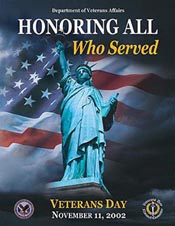
|
Ketchikan: The Ketchikan School
Board will hold a regular meeting on Wednesday, November 13th.
The meeting will be held in the City Council Chambers and is
scheduled to begin at 6:00 pm. Among the items on the agenda
are the interviews of candidates for the board position vacated
when Mike Lyshol resigned. The candidates to be interviewed are
Deb Harney and Mike Harpold.
Download the agenda. ... Saturday - November
09, 2002 - 11:55 am ... Saturday - November
09, 2002 - 11:55 am
Profile America - East Coast Blackout
 Listen
To This Story In RealAudio - Saturday, November 9th. Darkness
crept over much of the Northeastern United States and into Canada
at 5:16 p.m. on this date in 1965. A massive electrical blackout
eventually enveloped 80-thousand square miles, putting the health
and safety of 30-million people at risk for 13 long hours. As
Americans learned how vulnerable they were to the failures of
modern technology, President Johnson demanded an immediate investigation
to ensure that such a frightening event would never occur again.
Today, more than 3-trillion kilowatt hours of electricity are
generated each year by U.S. power companies. The average household
pays $1,338 on energy costs each year. (Source U.S. Census Bureau) Listen
To This Story In RealAudio - Saturday, November 9th. Darkness
crept over much of the Northeastern United States and into Canada
at 5:16 p.m. on this date in 1965. A massive electrical blackout
eventually enveloped 80-thousand square miles, putting the health
and safety of 30-million people at risk for 13 long hours. As
Americans learned how vulnerable they were to the failures of
modern technology, President Johnson demanded an immediate investigation
to ensure that such a frightening event would never occur again.
Today, more than 3-trillion kilowatt hours of electricity are
generated each year by U.S. power companies. The average household
pays $1,338 on energy costs each year. (Source U.S. Census Bureau)
|
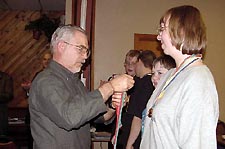
Assemblymember Dick Coose has
the honor of presenting the Special O Bowling Tournament awards
to the Special Olympians of Team Ketchikan. Jamie Fitzgerald
smiles as she is presented another medal by Coose....
Photo by Gigi Pilcher...
|
 Ketchikan:
Local Special Olympics Bowling Tournament Held Ketchikan:
Local Special Olympics Bowling Tournament Held
Team Ketchikan Heads To State Special Olympics Bowling Tournament
Next Week...
Friday - November 08, 2002
- 12:50 am
Photo Gallery
Click on the photo or link
to read the story and to view more photos by Gigi Pilcher and
Mike Gates...
|
Profile America
- First
Women's College
 Listen
To This Story In RealAudio- Friday, November 8th. The disparity
in wages between men and women led to the founding of the first
college for women in the U.S., on this date in 1837. In the early
part of the 19th century, large numbers of men moved West, seeking
better opportunities, and creating a need for teachers. At the
age of 17, Mary Lyon accepted a teaching job earning just $3
a month, far less than the $10 to $12 earned by men. The experience
ignited a desire to further her own education, and the challenges
she faced led her to establish Mount Holyoke Seminary in South
Hadley, Massachusetts, the first women's college in the nation.
Today, there are just over 9-million women attending college,
compared to less than 7-million male students. (Source U.S. Census Bureau) Listen
To This Story In RealAudio- Friday, November 8th. The disparity
in wages between men and women led to the founding of the first
college for women in the U.S., on this date in 1837. In the early
part of the 19th century, large numbers of men moved West, seeking
better opportunities, and creating a need for teachers. At the
age of 17, Mary Lyon accepted a teaching job earning just $3
a month, far less than the $10 to $12 earned by men. The experience
ignited a desire to further her own education, and the challenges
she faced led her to establish Mount Holyoke Seminary in South
Hadley, Massachusetts, the first women's college in the nation.
Today, there are just over 9-million women attending college,
compared to less than 7-million male students. (Source U.S. Census Bureau)
|
Our Earth
As Art
The tongue of the Malaspina
Glacier, the largest glacier in Alaska, fills most of this image.
The Malaspina lies west of Yakutat Bay and covers 1,500 sq. MI
(3,880 sq. km). -- Click on the photo or link to view the Landsat
7 Earth As Art Gallery
Landsat 7 satellite - Photo
courtesy USGS & NASA
|
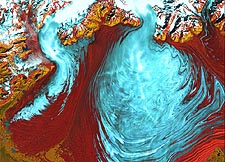
|
Alaska: Flags
Lowered Thursday In Memory Of Peter Reader - Former
Nome Miner was Delegate to Constitutional Convention...
Thursday - November 07,
2002 - 12:45 am
Alaska: Knowles Declares Flooding, Earthquake Disasters - Disaster Policy Cabinet Recommends Action Following
7.9 Quake, Kenai Flooding; Knowles Also Takes Action to Assist
Shishmaref...
Thursday - November 07,
2002 - 12:45 am
Profile America - Nobel Prizes
 Listen
To This Story In RealAudio - Thursday, November 7th. The
Nobel Prize for literature went to an American author for the
first time this week in 1930. It was awarded to Sinclair Lewis,
whose novels about the conflict between idealism and narrow mindedness
in small towns had made him one of the nation's most widely read
authors. His works included Main Street, Arrowsmith and Elmer
Gantry. One novel, named Babbitt, even sparked a new word - "babbittry"
- to describe conformity and commercialism. Lewis wrote 22 novels
and three plays. Several were made into movies, and one was awarded
the Pulitzer Prize - which he declined. Americans have won eight
Nobel Prizes for literature; 16 Peace Prizes; and 199 prizes
in physics, chemistry and medicine. (Source
U.S. Census Bureau) Listen
To This Story In RealAudio - Thursday, November 7th. The
Nobel Prize for literature went to an American author for the
first time this week in 1930. It was awarded to Sinclair Lewis,
whose novels about the conflict between idealism and narrow mindedness
in small towns had made him one of the nation's most widely read
authors. His works included Main Street, Arrowsmith and Elmer
Gantry. One novel, named Babbitt, even sparked a new word - "babbittry"
- to describe conformity and commercialism. Lewis wrote 22 novels
and three plays. Several were made into movies, and one was awarded
the Pulitzer Prize - which he declined. Americans have won eight
Nobel Prizes for literature; 16 Peace Prizes; and 199 prizes
in physics, chemistry and medicine. (Source
U.S. Census Bureau)
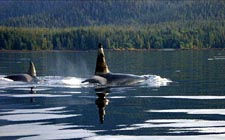 |
Orcas
by Ed Irizarry -
Ketchikan, AK
Front Page Photo
Wednesday - November 05,
2002
Click on the photo
to view a larger photo...
|
Profile
America - John
Philip Sousa
 Listen
To This Story In RealAudio - Wednesday, November 6th. This
is a special day for anyone who ever played in a marching band
- it's the birthday of John Philip Sousa, born in Washington,
D.C., in 1854. He composed some of the nation's most enduring
marches, including The Stars and Stripes Forever, Semper Fidelis
and El Capitan. It's been said that his talent for composing
marches has never been equaled and that his band conducting remains
without parallel. Sousa marches are still played by school, community
and military bands at free public concerts. In addition, some
31-million people a year pay to attend symphonic performances.
Today, there are about 161-thousand professional musicians and
composers in the U.S., about a third of them women. (Source U.S. Census Bureau) Listen
To This Story In RealAudio - Wednesday, November 6th. This
is a special day for anyone who ever played in a marching band
- it's the birthday of John Philip Sousa, born in Washington,
D.C., in 1854. He composed some of the nation's most enduring
marches, including The Stars and Stripes Forever, Semper Fidelis
and El Capitan. It's been said that his talent for composing
marches has never been equaled and that his band conducting remains
without parallel. Sousa marches are still played by school, community
and military bands at free public concerts. In addition, some
31-million people a year pay to attend symphonic performances.
Today, there are about 161-thousand professional musicians and
composers in the U.S., about a third of them women. (Source U.S. Census Bureau)
 Profile America - Election Day
Profile America - Election Day
 Listen
To This Story In RealAudio Tuesday, November 5th. This is
the first Tuesday after the first Monday of the month - and it's
an even-numbered year - meaning it's Election Day. Across the
country, voters are going to the polls to cast their ballots
for a wide range of local, state and federal offices, including
all members of the House of Representatives and one-third of
the U.S. Senate. This will be the first election with new congressional
districts - drawn on results of the 2000 Census. More than 200-million
people are of voting age in the U.S. In the last nonpresidential
general elections in 1998, 62 percent of eligible voters reported
that they were registered, but only 42 percent said they went
to the polls. Listen
To This Story In RealAudio Tuesday, November 5th. This is
the first Tuesday after the first Monday of the month - and it's
an even-numbered year - meaning it's Election Day. Across the
country, voters are going to the polls to cast their ballots
for a wide range of local, state and federal offices, including
all members of the House of Representatives and one-third of
the U.S. Senate. This will be the first election with new congressional
districts - drawn on results of the 2000 Census. More than 200-million
people are of voting age in the U.S. In the last nonpresidential
general elections in 1998, 62 percent of eligible voters reported
that they were registered, but only 42 percent said they went
to the polls.
"A Good Bear
Day"
by Ed Irizarry of
Ketchikan
Front Page Photo
Monday - November 04, 2002
Click on the photo
to
view a larger photo...
|
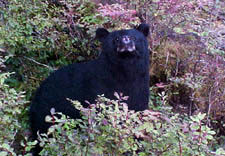
|
Alaska: Governor Seeks Protection From Chilean Salmon
Exports -- Cites Dumping, Overproduction, Lax Enforcement
in Farmed Salmon Industry...
Monday
- November 04, 2002 - 10:40 pm
Ketchikan:
Rainy Day Quilters Announce Heirloom Quality
Quilt Raffle
- Tickets go on sale Nov. 5th...
Monday
- November 04, 2002 - 10:20 pm
Profile America -- New York Marathon
 Listen
To This Story In RealAudio - Sunday, November 3rd. More than
2-million spectators are expected to line the route for today's
New York City Marathon. They'll see over 30-thousand athletes
from 100 countries competing in what has become the best known
marathon in the world. The top male runner last year was from
Ethiopia, while the women's crown went to a Kenyan. The first
New York City Marathon was held in 1970, with just 127 runners
and an audience of about a hundred. The budget for the event
was so tight that unused bowling trophies were recycled to present
to the winners. Some 22-million Americans enjoy running and jogging.
Nearly 340-thousand high school students compete in cross-country
events, and 23-thousand pursue the sport in college. (Source:
U.S. Census Bureau) Listen
To This Story In RealAudio - Sunday, November 3rd. More than
2-million spectators are expected to line the route for today's
New York City Marathon. They'll see over 30-thousand athletes
from 100 countries competing in what has become the best known
marathon in the world. The top male runner last year was from
Ethiopia, while the women's crown went to a Kenyan. The first
New York City Marathon was held in 1970, with just 127 runners
and an audience of about a hundred. The budget for the event
was so tight that unused bowling trophies were recycled to present
to the winners. Some 22-million Americans enjoy running and jogging.
Nearly 340-thousand high school students compete in cross-country
events, and 23-thousand pursue the sport in college. (Source:
U.S. Census Bureau)
Ketchikan:
Assembly Meets Monday, Nov. 4th - Relocation
of Borough Offices; Lighthouse; Areawide fire and emergency medical
services; Possible GFP litigation; School construction site;
and much more to be considered....
Saturday - November 02,
2002 - 12:20 pm
Alaska: Murkowski
Decries Ad Distortions, Expresses His Support for Tribal Governments...
Saturday - November 02,
2002 - 12:05 am
Profile
America -- Daniel Boone
 Listen
To This Story In RealAudio - Saturday, November 2nd. This
is the birthday of one of young America's most famous frontier
figures - Daniel Boone. He was born on this day in 1734, near
Reading, Pennsylvania - not in Kentucky, where his name is linked
to the area's exploration. Boone led an adventurous life, captured
by the Shawnee Indians and then by the British, and continued
to hunt into his 80s. He is best remembered for charting a course
through the Cumberland Gap and opening up the Kentucky frontier.
His life sparked a popular television series in the 1960s, starring
Fess Parker. When Boone explored Kentucky in the 1770s, settlers
there numbered only about 16-thousand. Today, just over 4-million
people call Kentucky home. (Source:
U.S. Census Bureau) Listen
To This Story In RealAudio - Saturday, November 2nd. This
is the birthday of one of young America's most famous frontier
figures - Daniel Boone. He was born on this day in 1734, near
Reading, Pennsylvania - not in Kentucky, where his name is linked
to the area's exploration. Boone led an adventurous life, captured
by the Shawnee Indians and then by the British, and continued
to hunt into his 80s. He is best remembered for charting a course
through the Cumberland Gap and opening up the Kentucky frontier.
His life sparked a popular television series in the 1960s, starring
Fess Parker. When Boone explored Kentucky in the 1770s, settlers
there numbered only about 16-thousand. Today, just over 4-million
people call Kentucky home. (Source:
U.S. Census Bureau)
"Majestic Orcas"
Indian Point around
Loring...
photo by Ed Irizarry
Ketchikan, AK
Front page photo:
Friday - November 01, 2002
Click on photo to view
a larger photo...
|
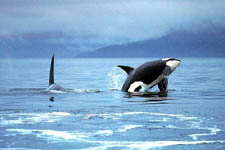
|
Alaska: Two Alaska Educators Honored For Excellence
-- Bethel Teacher, Anchorage Principal Earn $25,000 Milken Award...
Friday - November 01, 2002
- 12:30 am
Ketchikan: UAS Ketchikan Invites Community To Open House...
Friday - November 01, 2002
- 12:30 am
Profile
America -- First
Forward Pass
 Listen
To This Story In RealAudio - Friday, November 1st. College
football changed forever on this day in 1913, when the first
forward pass was thrown by Notre Dame in a game against Army
at West Point. Notre Dame won, 35 to 13. Just the year before,
the forward pass had been authorized by a rules committee of
what would become the National Collegiate Athletic Association.
The committee had been set up at the urging of President Theodore
Roosevelt to save the game - then under widespread criticism
for many injuries and deaths on the playing field, and even banned
by a number of schools. Today, football is one of the most popular
college sports, played by 600 teams and cheered on by nearly
40-million fans, as well as millions more on television. (Source: U.S. Census Bureau) Listen
To This Story In RealAudio - Friday, November 1st. College
football changed forever on this day in 1913, when the first
forward pass was thrown by Notre Dame in a game against Army
at West Point. Notre Dame won, 35 to 13. Just the year before,
the forward pass had been authorized by a rules committee of
what would become the National Collegiate Athletic Association.
The committee had been set up at the urging of President Theodore
Roosevelt to save the game - then under widespread criticism
for many injuries and deaths on the playing field, and even banned
by a number of schools. Today, football is one of the most popular
college sports, played by 600 teams and cheered on by nearly
40-million fans, as well as millions more on television. (Source: U.S. Census Bureau)
More Stories In the News -- News & Photos
Archive ......
Sitnews
Stories in the News
|





